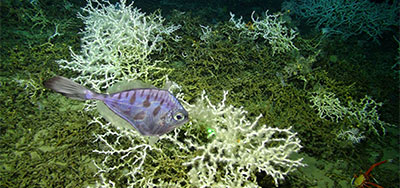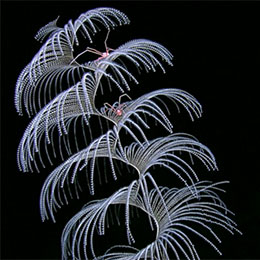Deep-Sea Corals
Deep-sea corals, like their warm-water cousins, are actually colonies of small animals that build a common skeleton, which grows into many shapes and colors. Unlike tropical reefs, they live from 150 feet to more than 10,000 feet below sea level, where sunlight is dim to nonexistent. Instead of forming rock-like reefs, these cold-water corals form groves of tree, feather, column, or fan shapes, sometimes reaching dozens of feet tall. They provide crucial habitat, refuge, and nursery grounds for fish, shrimp, and crabs. They feed on organic matter that rains down from surface waters into the deep. These ecosystems are some of the richest and most diverse in the deep sea, yet they are often unknown, and unexplored. Bottom trawling, oil and gas exploration, and ocean acidification threaten these ecosystems. They are slow growing and long lived (from decades to millennia), and require very long timescales to recover from disturbance.
Deep-Sea Habitat Conservation
Rocky reefs in deep offshore waters of the U.S. are a haven for deep-sea
corals, and hotspots of biodiversity where fish, sea stars, crabs, and shrimp are abundant. Since 2009, deep-sea corals are protected in many areas as ‘essential fish habitat’ under the Magnuson-Stevens Sustainable Fisheries Conservation Act. Our projects work closely with NOAA’s Deep Sea Coral Research and Technology Program, National Marine Sanctuaries, and regional Fishery Management Councils to identify and protect deep-sea coral aggregations. Our surveys and explorations have been successful at establishing new marine protected areas on Alaska’s Seamounts, the Gulf of Farallones, Southern California’s Borderlands, and in the Gulf of Mexico. Our efforts contributed to the expansion of National Marine Sanctuaries, as well, based on the images and samples collected by our field teams, partners, and projects.

Deep-Sea Habitat Restoration
Mesophotic and deep benthic communities are vast and complex ecosystems on the ocean floor that are a foundation of Gulf of Mexico food webs. In 2010, more than 770 square miles of deep-sea habitat and four square miles of mesophotic habitat were damaged by the Deepwater Horizon oil spill.
The biological footprint of the spill was enormous. Hundreds of deep-sea corals were found to be injured as a result of the spill, with many more likely. This was the largest oil spill in U.S. history, and the largest environmental settlement case, which was settled with BP in 2017 for $21 billion dollars. Those funds will be used to restore the Gulf’s mesophotic and deep benthic communities through a portfolio of projects.
Deep-Sea Climate Vulnerability
Deep-sea corals grow in extreme conditions, far offshore in cold, acidic waters where changing ocean conditions can be difficult to detect. Warming oceans threaten deep water communities because they are stenothermal (intolerant of temperature fluctuations), adapted to stable cold-water conditions. Acidified oceans may also be a threat, because stony coral skeletons are comprised of aragonite, a form of calcium carbonate that dissolves under acidified conditions. Scientific studies led by our program help to understand the resilience of deep-water species to a changing climate. Deep-sea corals are long-lived animals. Like trees, they grow to be very old and are sessile, or fixed in place. Their branches provide substrate and refuge to many associated species. So, any natural or anthropogenic threats to deep-sea corals can bring changes to this ecosystem.






